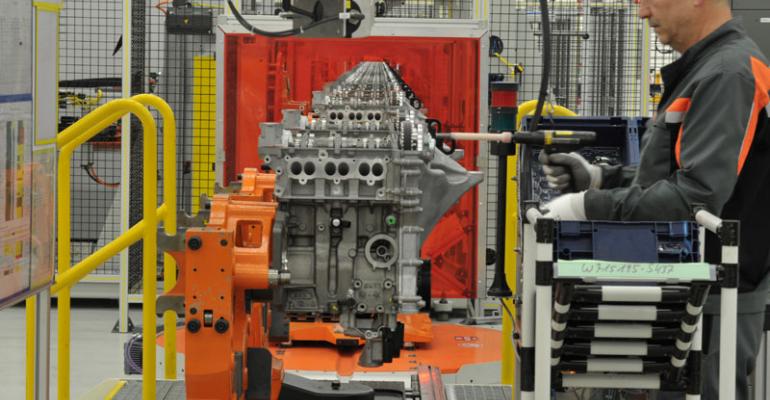DEARBORN, MI –Ford plans to add more derivatives to its direct-injected turbocharged EcoBoost engine family as the auto maker celebrates producing 2 million units since the mills were launched in 2009.
Ford offers five EcoBoost engines globally, including a 1.0L, 1.5L, 1.6L, 2.0L and 3.5L, and more are on the way, says a top executive.
“We’re not going to stop with five,” Joe Bakaj, vice president-powertrain engineering, tells WardsAuto at a media event here, declining to reveal the timing of the new offerings. “We’re going to continue to work on new EcoBoost engines.”
Ford is enjoying success with its line of downsized EcoBoost mills. The auto maker says the take rate for the 1.6L and 2.0L EcoBoost on the Escape cross/utility vehicle is 90%, while 50% of Fusion sedan buyers choose one of three EcoBoost engines available.
By the end of this year, EcoBoost engines will be available on more than 90% of Ford’s North American nameplates, rising to 95% by 2015.
To keep pace with demand, Ford has injected new investment in several EcoBoost plants, including putting $200 million into its Cleveland, OH, facility where the 2.0L is built.
In Europe, the auto maker is doubling capacity at its Cologne, Germany, plant to more than 1,000 engines a day to boost output of its 1.0L 3-cyl. engine, which is offered in several European vehicles and will make its way to the North American Fiesta later this year.
More than 100,000 EcoBoost engines are now being built each month, with a target of 1.2 million this year, up more than 60% from 2012. For the first time, EcoBoost output is expected to exceed Ford’s global diesel-engine production.
Bakaj says EcoBoost’s popularity in Europe doesn’t mean the end of diesels there, where they remain a popular choice among consumers. In North America, however, EcoBoost offers a better value proposition than diesels in passenger vehicles, the executive says.
“There’s still a challenge on the payback period in the U.S. because of the price of diesel, which is about 10% higher than gas,” Bakaj says. “But if the market takes off on passenger-car diesels, with our global product strategy, we’ve already engineered the diesels to work with our key global top hats.”
EcoBoost engines may be offered on more vehicles in the future, Bakaj says, noting the auto maker had that strategy in mind when it announced earlier this year it was developing 9-speed front-wheel-drive and 10-speed rear-wheel-drive transmissions.
“If you’re able to use 9- or 10-speed transmissions, you’re able to further downsize, because you have that shorter first-gear ratio to launch,” he says.
In the future, all Ford vehicles may come standard with EcoBoost engines, with no naturally aspirated mills offered. Bakaj says it may be the only way to meet looming government fuel-economy mandates that call for auto makers’ fleets to achieve 56.5 mpg
(4.1 L/100 km) by 2025.
“At some point, you will have to have base engines with more technology as standard. Otherwise, there’s no way you can get to that number,” he says. “Yes, you’d pay a little more, but you’d get the money back in fuel (savings).”
The EcoBoost’s success is more than just a tribute to the technology that offers greater fuel economy without sacrificing performance. It’s also a marketing coup for Ford, as the EcoBoost name is the most recognizable engine brand behind Chrysler’s Hemi, says Amy Marentic, Ford group marketing manager-global cars and crossovers.
“Those that are aware of EcoBoost are more favorable overall to the Ford brand, and that is what we’re most proud of,” she says. “When we ask customers what they think of EcoBoost, they say good gas mileage and low emissions. The imagery we’ve been going for is what customers are repeating back to us.”
But despite the favorable opinions of EcoBoost, car buyers don’t know much about the technology behind EcoBoost, Marentic says, noting only 18% of customers are aware the engines are turbocharged.
“Most customers don’t even know the displacement of their engine,” she says.





